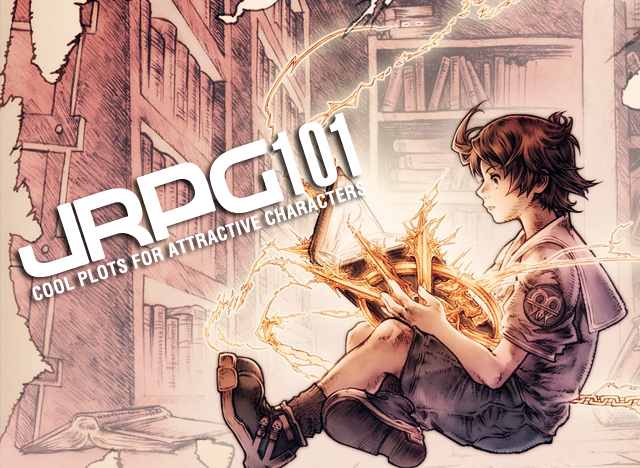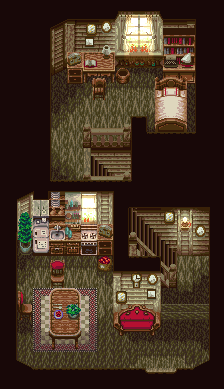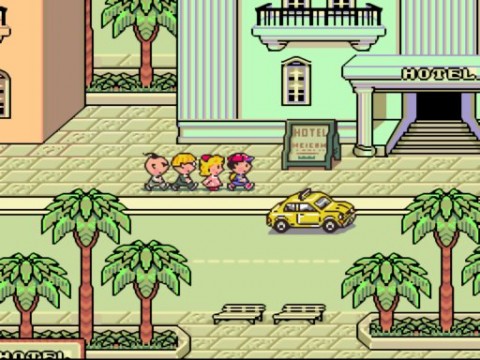 So you’ve played Japanese role-playing games all your life, from Dragon Quest to Fragile Dreams, and you’ve decided to cash in on this whole JRPG business by writing your own game. That’s great, the world can always use another JRPG! But the JRPG has a detailed, storied history with just-as-detailed, just-as-storied keystones. From powerful crystals to industrial evil, sprawling overworlds to relentless level-ups, big hair to bigger weapons (admittedly not important in the plot, but come on), the Japanese role-playing game has a slew of ideas that not even you, Mr. Hot Shot RPG Writer, can deny. You’ve got your work cut out for you.
So you’ve played Japanese role-playing games all your life, from Dragon Quest to Fragile Dreams, and you’ve decided to cash in on this whole JRPG business by writing your own game. That’s great, the world can always use another JRPG! But the JRPG has a detailed, storied history with just-as-detailed, just-as-storied keystones. From powerful crystals to industrial evil, sprawling overworlds to relentless level-ups, big hair to bigger weapons (admittedly not important in the plot, but come on), the Japanese role-playing game has a slew of ideas that not even you, Mr. Hot Shot RPG Writer, can deny. You’ve got your work cut out for you.
 First things first: where’s your JRPG going to start? In a remote village, famed for its ancient magical powers? How about in some gigantic castle, its kingdom the size of, well, a small town? Or, actually, doesn’t starting off in your bed, being woken up by your mom, sound nice? Players decide whether or not they really want to invest fifty hours on some chump’s JRPG, just based on just those first few minutes, so you’d better make a good impression.
First things first: where’s your JRPG going to start? In a remote village, famed for its ancient magical powers? How about in some gigantic castle, its kingdom the size of, well, a small town? Or, actually, doesn’t starting off in your bed, being woken up by your mom, sound nice? Players decide whether or not they really want to invest fifty hours on some chump’s JRPG, just based on just those first few minutes, so you’d better make a good impression.
(And don’t even think about starting in someplace crazy, like in some post-apocalyptic nuclear wasteland, or a grungy catacomb prison. That’s where western RPGs live, and you don’t want to be friends with those guys.)
But remember, you need to fill all these towns and castles (or whatever) with lots and lots of non-player characters, and give them lots and lots of story details that nobody really cares about. But watch out! Make sure certain dialogue is actually crucial to the plot, or at the very least the answer to some obscure puzzle that unlocks the most powerful (and of course most secret) weapon in the game. More importantly, make sure those NPCs only say this dialogue when prompted with an item that has a 0.5% drop rate from an uncommon monster encounter. That way, only the players who are extremely dedicated will get everything in the game. The essence of JRPGs is to be obscure about everything.
Sometimes, though, you’ll want to string the player along like a brilliant puppet master, or at least some kind of Hansel-and-Gretel-esque witch, throwing tiny plot details every which way and smiling as you watch players scramble around, trying to find out just where they’re supposed to go next. This is where books come in. Make sure every house in every town has at least one bookshelf, and that each bookshelf has only one book on it (despite, of course, looking like it has about eighty.) Then, make sure each book has only one letter on each of its pages. This will in turn make sure that each book has only enough room for a couple complete sentences, while filling out enough pages to make the tome look nice and thick. Sure, some environmentalists will probably yell at you for even considering such a paper-wasting idea, but just write it off as another dark product of the evil in-game industrialist country. And besides, those books give important story details. They’re important!
Setting stuff notwithstanding, the story has to be pretty much the most epic thing you’ve ever seen, and if you’ve ever played a JRPG, you know what you’ve got to do. Firstly, it’s a proven fact that nothing makes life crazy for your spiky-haired heroes/abnormally well-developed heroines (more on that later) than their hometown being burnt to a crisp– or, at the very least, having their home village kick ’em out due to irreconcilable differences. It just fills players with hate and vengeance, and of course, any JRPG developer worth its salt knows that plenty of hate and vengeance is necessary in a JRPG. After all, you’ve got to go through a (possibly optional) redemption sidequest later on (again, more on that later), and you’ll need something to redeem yourself for.
Alternatively, your heroes and heroines might even be better than the evil they fight, ignoring the relentless surge of the dark side as they refuse to kill their mortal enemy. Instead, they’ll send them back into the ether, hoping they’ll change their evil ways– or, in super rare cases, pick ’em right up and put them into their party along with them. Then you’ll fight against the real Big Bad, who, of course, is going to be a monstrous dude with a penchant for exclusively multisyllabic (or monosyllabic) conversation, as well as controlling sprawling imperial/industrial empires. He’ll be just ripe for a abrupt, violent defeat, of course. (Unless it’s your hero’s dad, or cousin twice-removed, or other dad or something, in which case you can insert a lovely, heartbreaking CG cutscene as the boss dies a very much touching death.) In any case, it’ll be a victory for the goody-two-shoes, and morally unambiguous victories like those are the most thought-provoking out there.
 Speaking of goody-two-shoes, you really should pay attention to the kinds of characters you put in that JRPG, too. Specifically, the one most important part of your characters: hair. Look at Final Fantasy and you’ll instantly see the merits of great hair– the better the hair, the better the stats of the character. You know this, the players know this, everybody knows this– so you might as well go along with it. Nobody’s going to pay attention to a character who’s bald, even if he’s a rad martial artist with crazy tattoos covering the entirety of his nearly-nude, extremely muscular body. (Note: This is unless the martial artist is female, in which case said nearly-nude female gets as much attention as anyone can spare, even if she’s bald.). So design characters with great hair, and do it for everyone even mildly important in your game. Your rule of thumb should be if a character’s hair doesn’t seem like it needed emptying an entire canister of hair gel, or at least a whole hour of blow-drying, it shouldn’t exist. Warning: characters with hair colors found normally in nature are characters you don’t want to use.
Speaking of goody-two-shoes, you really should pay attention to the kinds of characters you put in that JRPG, too. Specifically, the one most important part of your characters: hair. Look at Final Fantasy and you’ll instantly see the merits of great hair– the better the hair, the better the stats of the character. You know this, the players know this, everybody knows this– so you might as well go along with it. Nobody’s going to pay attention to a character who’s bald, even if he’s a rad martial artist with crazy tattoos covering the entirety of his nearly-nude, extremely muscular body. (Note: This is unless the martial artist is female, in which case said nearly-nude female gets as much attention as anyone can spare, even if she’s bald.). So design characters with great hair, and do it for everyone even mildly important in your game. Your rule of thumb should be if a character’s hair doesn’t seem like it needed emptying an entire canister of hair gel, or at least a whole hour of blow-drying, it shouldn’t exist. Warning: characters with hair colors found normally in nature are characters you don’t want to use.
It’s not as important as hair, but be adamant about clothing choices, too. Make sure your design department gets a few things right; for example, the more magically or religiously inclined your characters, the skimpier their outfits should be. You want to make your players think about what it means if a priestess is wearing nothing but a miniskirt and a giant rosary conveniently covering up her (either extremely well-endowed or extremely not well-endowed) chest. And then, you can show off your wondrous game design acumen by having a tooltip that says the outfit “magically augments defenses so much that normal clothes are no longer necessary, and also it makes the Almighty like you better.” (That’ll get those pesky gamers.) And when you run out of ideas for outfits, just take a break. The best character designers know that inspiration starts at home– namely, your home’s furniture. It’s a little-known secret, for example, that curtains make great summoner sleeves.
Least important of all in character development is personality. Nobody really cares or expects anything new, really– that’s one of the perks of designing a JRPG. Just go to the local personality bargain bin and fish out a few choice stereotypes. For your initial party, you’ve got your choice of Brooding Teenage Angst-master, Squeaky Pigtailed Sex Symbol, Introspective White-Garbed Summoner (with a side of Dream Girl) and Grumpy-on-the-Outside, Squishy-on-the-Inside Antihero; later party members can go really crazy with Lovable Yet Pretty Useless Mascot, Overenthusiastic Gunman (or Archer) with an Indiscernible Accent or even Enigmatic and Overpowered Swordsman Who’s (Surprise) the Main Character’s Dad (or at Least the Main Character from the Future). For a really groundbreaking party, mix and match these traits throughout the game so that eventually all the characters are totally interchangeable and indistinguishable from one another. Then call this character development.
 As good as your stories and characters are, though, you’ve got to get your players all motivated for their fantasy, too. Fortunately, this isn’t too difficult. Some subtle (or not-so-subtle) romances between your host of characters does the trick pretty well– just look at how Harvest Moon pulls this off, and you’ll see just how effective a drop of dating sim can be in getting your players all hot and bothered. This also makes sure you can pull off multiple endings without trying too hard (i.e. using time travel, or some other silly device like that.) And if it’s one thing JRPG players like, it’s spending inordinate amounts of time manipulating digital relationship stats to get that perfect ending.
As good as your stories and characters are, though, you’ve got to get your players all motivated for their fantasy, too. Fortunately, this isn’t too difficult. Some subtle (or not-so-subtle) romances between your host of characters does the trick pretty well– just look at how Harvest Moon pulls this off, and you’ll see just how effective a drop of dating sim can be in getting your players all hot and bothered. This also makes sure you can pull off multiple endings without trying too hard (i.e. using time travel, or some other silly device like that.) And if it’s one thing JRPG players like, it’s spending inordinate amounts of time manipulating digital relationship stats to get that perfect ending.
Above all, remember: JRPGs are only good as their plot design. Sure, your programmers might toil day and night to craft the perfect battle mechanics, or that amazingly innovative class system, but if your story’s about something incredibly dumb and unoriginal, like a kid with a baseball bat saving America from some fat kid in a robot suit, nobody will ever like your game. (Or you.) So get out there! Write that amazingly non-derivative story! And when you’re done, you’ll have enabled millions of people to save the world, millions of times over. Not so bad for just another writer.




 ShareThis
ShareThis







Awesome article, I totally lawled hard :P
And imagine how powerful JRPG heroes could really be if 95% of their magical power wasn’t holding up their gravity defying colour changing hair. It’s really worth thinking about.